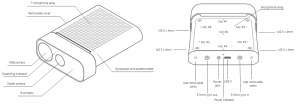Kinect Azure
The Kinect Azure motion sensor enables real-time interpretation of human motion, offering possibilities for gesture recognition, skeletal tracking, and interactive experiences. It is interoperable with game development engines such as TouchDesigner and Unity, making it accessible to creators and developers. The sensor can be used to create immersive installations, live performances, generative art projects, games, and virtual reality experiences that leverage the power of human motion and spatial tracking. Overall, the Kinect Azure motion sensor is a powerful tool for creating innovative and engaging experiences.
In addition to its motion tracking capabilities, the Kinect Azure motion sensor also offers real-time point cloud functionality. This allows the sensor to capture a 3D representation of the environment in real-time, creating a detailed map of the surrounding objects and spaces. This feature can be used in a variety of applications, such as 3D scanning, robotics, and augmented reality.
Real-time point clouds allow for precise object recognition and tracking, enabling the creation of immersive augmented reality experiences that blend real and virtual objects seamlessly. It can also be used in robotics applications, where the sensor can be used to detect and avoid obstacles in real-time. Furthermore, 3D scanning can benefit from the Kinect Azure's ability to capture high-quality point clouds in real-time, allowing for fast and accurate scanning of objects and environments.

